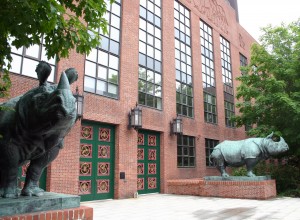The Agassiz Neighborhood Path Enlightens Walkers, Encourages Good Health
 According to the newly issued Agassiz Neighborhood Path booklet, William Dean Howells described this part of Cambridge, where he lived from 1866 to 1870, as “‘a frontier between city and country’ where ‘the voices of cows’ mingled with the whistles of nearby locomotives.” Cows no longer live in the Agassiz neighborhood, but four different neighborhood paths will take walkers to visit a pair of rhinoceroses, two different whales, and the spot where Bill Gates wrote the software code that launched Microsoft.
According to the newly issued Agassiz Neighborhood Path booklet, William Dean Howells described this part of Cambridge, where he lived from 1866 to 1870, as “‘a frontier between city and country’ where ‘the voices of cows’ mingled with the whistles of nearby locomotives.” Cows no longer live in the Agassiz neighborhood, but four different neighborhood paths will take walkers to visit a pair of rhinoceroses, two different whales, and the spot where Bill Gates wrote the software code that launched Microsoft.
Community organizers, with assistance from the Agassiz Baldwin Community, have researched, designed, and written an updated version of a booklet first published in 2011 with new routes and new destinations, including a tree walk that highlights the neighborhood’s botanical diversity. Catherine Weller, one of the booklet’s contributors, credits neighborhood resident Seddon Wylde with the project’s initial spark. “Her idea was that walking provided health benefits and adding information about interesting sites would make it more likely that people would extend their walking routes.” Each path is designed for a walk lasting about 45 minutes to an hour.
At each stop on the path, the booklet provides fascinating tidbits, some historical (“An explosion in the [Cambridge Electron Accelerator] lab one July night in 1965 rocked the Agassiz neighborhood and killed a graduate student.”), some philosophical (“The [sycamore] tree bark is in a constant state of ‘becoming’ with no fewer than 3 layers visible at a time.”) and some humorous (The entry for John Kenneth Galbraith’s home reveals the results of a 1955 FBI report on Galbraith: “Investigation favorable except conceited, egotistical and snobbish.”). Weller’s most surprising discovery while researching the locations was that Sacramento Field, now a popular playground with a baseball diamond, a soccer field and a basketball court, was once a reservoir for a textile processing plant.
A website for further information is listed at the bottom of each location description, so walkers can use a smartphone en route to learn more about the installation of the two whale skeletons at Harvard’s Northwest Laboratory or the arrival of Bessie and Victoria, the two rhinoceros statues outside the Harvard Biological Laboratories. Or the walker can save the searching for the home computer and simply enjoy the walk, staying alert to each sight and sound, just in case the ghostly mooing of cows drifts down the sidewalk. In this neighborhood—as the new booklet amply illustrates—stranger things have happened.
The Agassiz Neighborhood Path booklet is available online and printed copies can be picked up at the Agassiz Baldwin Community.



